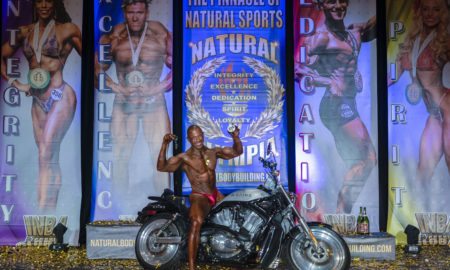Randy’s training and gaining were going very well as we neared the all-too-brief Massachusetts summer. In late May we had just come through the worst rains and flooding in more than 70 years, and we were ready for some sunshine. Of course, my aging mom, who was eight years old at the time of the last flood, dismissed our recent deluges as mere drizzle compared to the Great Flood of ’36.
“Oh, really?” I challenged her, expecting a story of a great ark with two animals of every type aboard landing atop Mount Ararat.
“The cities were all deep under water, evil pirates in an old oil tanker raided the peaceful settlers of Waterworld’s floating towns, and our only hope was a man with gills that looked a lot like Kevin Costner.”
Perhaps I should explain that my mother has Alzheimer’s disease and watches cable TV for roughly 16 hours a day. She sold my childhood home about 10 years ago because she was seriously concerned that living alone in a large house put her at an increased risk of being abducted by aliens. Alien abduction hasn’t been a large problem in suburban Boston for some time (I understand it was pretty bad in the ’70s, though that may have been due to bad acid trips), but I suppose one can never be too careful. All I know is that those pesky aliens won’t have my dear old mom to poke and probe.
Anyway, back to Randy, our man with the plan to win the novice division of a local show being held this fall. He had indeed reached his goal weight of 225 pounds; however, as I’m always pointing out, weight in and of itself is meaningless. Bodybuilders are judged visually, based on size but also shape, symmetry, proportion and condition. In Randy’s case there was still a proportion issue that needed to be addressed before I would be satisfied that he was ready to compete again. Specifically, his biceps were lagging.
Because his shoulders and triceps were pretty good and had improved, his biceps looked even worse in comparison. The last thing I wanted was for him to do what so many other unsuccessful bodybuilders had before him, which was to keep building up his strong bodyparts while the weak points remained mired in mediocrity. Those are the guys you hear dissed at contests for having no legs, no back, no calves, etc. They’re usually the same ones who like to bitch about how much better their strong parts were than anyone else’s, ignoring the fact that they look like human jigsaw puzzles. (Not to confuse them with the Jigsaw Killer of “Saw” fame, whose catchphrases are, “I’d like to play a game,” and, “Oh, yes, there will be blood.”)
“I’m starting to worry about your biceps,” I began, words I knew would instantly put him into defensive mode. He didn’t let me down.
“What are you talking about?” he blurted. “They aren’t that bad.” To prove his point, he hit a front double-biceps pose. I’m sure that in his mind those biceps were popping out of his tank top like mountain peaks, but they were actually more like gently rolling hills.
“Tell that to the judges in September and see if the Jedi mind trick really works,” I deadpanned. “They’re not that good, Randy.”
“Yeah, well, yours aren’t that great, either,” he replied, pouting.
“I didn’t say they were, but stop trying to change the subject. This isn’t about me; it’s about you, and I’m only trying to help. Do you want my help or not?”
“I guess, yeah, sorry,” he said, sulking. He was good at sulking.
“Okay, listen up, because I have a plan to get your biceps growing. I know it will work because I’ve been using it training with Janet, and my bi’s have—get this—grown.” I let that settle in for a moment and waited for his reaction. He knew how doggedly resistant to growth my arms are. Hearing that my arms had grown was like learning that Verne Troyer (Mini-Me in the Austin Powers movies) was becoming taller.
Suddenly, he was all ears.
“It’s all about being creative and coming up with totally new methods,” I explained. “Remember when you hurt your lower back and we managed to train around it?” He nodded.
“Yeah, I didn’t miss one workout, and I actually put on a little size from all the different things we were doing, like the seated movements and the slower rep speeds.”
“Exactly. We got creative and switched up your training completely. And another time you were having a problem eating enough protein every day. What did we do?”
“You started having me drink a small shake of a scoop of protein powder with every meal.”
“Right. That was being creative, because most people think you have to either have a solid meal or a shake—but not both at the same time. Now we are going to do some crazy things for your biceps every week for the next four weeks, and I am sure they will shock your bi’s so much that they will have no choice but to grow. For two weeks after the crazy workouts you’ll go back to standard fare—three or four straight sets of three exercises for eight to 10 reps. That way your biceps won’t fully adjust to the shocker workouts. Are you ready for something different?”
“Sure, why not,” he replied with all the enthusiasm of Paris Hilton at a convention of stamp collectors. He knew he was in for some pain.
The first exercise was a creative riff on 21s, the old curling trick where you do seven reps in each of three different segments of the range of motion: bottom half, top half and full reps. In this variation you use an EZ-curl bar for 36 reps, with your hand spacing changing throughout the set. You do the first 12 reps with your hands all the way out to the edges of the bar, up against the collars; the second 12 with a standard grip and the final 12 with your hands together in the middle of the bar. I handed Randy a 50-pound fixed bar.
“You must be joking,” he smirked. “Come on—I can go heavier than that.”
“Talk to me in a few minutes,” I responded.
He got through the first set of 36 reps without tremendous effort, though the lactic acid burn toward the end was rough. Randy shifted his grimace to a smile and pronounced, “Nice pump, but it wasn’t that hard.” He was still breathing hard.
“I know, I know. Do it again. Now!” He knit his brows but picked up the bar off the floor and did another round. This time I had to hold the bar for him to move his hands in because they were shaking so badly. The last few reps with his hands together had him cussing, and he had to swing them up pretty sloppily. I let him rest for about a minute before it was time to run though this killer twist on curls for the third and final time. I had to help him get a few of the reps toward the middle; then he had to drop the bar and use a 40-pound bar to finish the last 12 reps. Randy was sweating and sat down on a nearby bench. His arms were still locked in a curling position, as he couldn’t straighten them out.
“Okay,” he conceded, “those were insane. That was a good biceps routine, thanks.”
“Oh, you think we’re done?” I grinned. “Oh, no, little stud-puppet, the fun isn’t over yet!” He groaned and muttered a phrase I can’t repeat here, but I will say that my mother and I have never had that type of a relationship.
The next “set” was incline dumbbell hammer curls, working both arms at a time for 10 reps. Then I quickly pulled the seat back to a vertical position for 10 reps of alternate dumbbell curls. Finally, I had him stand up and do 10 more reps of hammer curls, both arms together, to failure, and then alternate arms to failure. He tried to use 30s but didn’t make it all the way through. By the third go-round Randy was lifting weights so light they could have been covered in pink rubber and used in an aerobics class. I assure you, however, they felt like Chevy engine blocks to those fried biceps of Randy’s.
The next day Randy’s biceps were so sore that he was certain he’d torn something. I had made sure his brutalized biceps were being supplied with all the nutrients they needed to recover and grow from the abuse they’d undergone. The next week we did it all over again with some more crazy exercises and techniques I dreamed up. Three days later I had him tape his cold, flexed arm, and to his astonishment, it was up just over an eighth of an inch. That may not sound like much, but if he can duplicate that tiny gain a few more times, guess what? His biceps will have grown significantly. Forget about all those bullshit ads that promise an inch on your arms in one day—as long as you train them 12 times in that day and have an equal amount of the advertiser’s high-priced creatine (loaded with sugar) and whey protein shakes. Small gains are nothing to sneeze at because they all add up.
The moral of the story is that getting creative is often the only solution when you’re stuck at a plateau. One definition of insanity is doing the same thing over and over again yet expecting a different response. It’s like a trapped bird that keeps trying to escape a room by flying into a glass window. Either that window needs to open, or that bird needs to start looking for another way out of the room. Don’t be afraid to come up with creative solutions to make progress. It’s often the ridiculous-sounding idea that turns out to be so crazy, it just might work!
Uh-oh, is that rain I hear starting up outside?
Editor’s note: Ron Harris’ new book Real Bodybuilding is available at www.RonHarrisMuscle.com. IM
















You must be logged in to post a comment Login